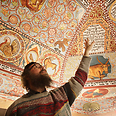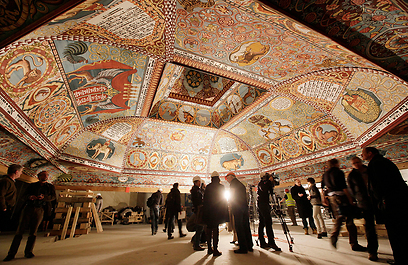
The wooden roof and ceiling will be a key attraction in the Museum of the History of Polish Jews, which is due to open next year in the heart of the city's former Jewish quarter. Reporters in Warsaw were invited to view it Tuesday.
Video courtesy of jn1.tv
The museum will tell the story of Jewish life in Poland, a complex history spanning 1,000 years, but one that has been forgotten today by many people and which is often overshadowed by the Holocaust.
The story will unfold largely with high-tech multimedia installations, but the reconstructed synagogue roof is a tangible object produced with the tools and techniques that were used when the original structure was first erected in the 1600s.
The ceiling is a rich panoply in milky blues and brownish reds of zodiac signs and animal symbols, along with inscriptions in Hebrew. Barbara Kirshenblatt-Gimblett, the program director of the museum's core exhibition, said some of the animals express Messianic yearnings prevalent in Polish Jewish communities after a period of wars and destruction in the 17th century.
"It's a heavenly canopy," Kirshenblatt-Gimblett said. "It's celestial. It's literally the heavens and the world to come."

Ceiling of reconstructed wooden synagogue (Photo: AP)
The animals include a red bull and a leviathan – a serpent-like sea monster – wrapped around Jerusalem. The iconography refers to stories saying that when the Jewish Messiah comes, there will be a banquet for the righteous where they will feast on the flesh of the red bull, which is a monster, and the leviathan. It was said the leviathan's skin would wrap itself around the city of Jerusalem and give off light.
Kirshenblatt-Gimblett said the reconstructed roof, with its "visualization of mystical texts, of prayer, of Messianic yearning," will allow museum visitors to experience the spirituality of the time.
"This represents the spiritual richness of Polish Jews," she said. "It says that they were not only people of the book in the literal sense of text, but that they had a rich visual imagination."
Architectural legacy wiped out by wars
The roof is the reconstruction of a 17th-century synagogue that underwent renovation in the 18th century in Gwozdziec, a town formerly in the Polish-Lithuanian Commonwealth that is now in Ukraine. It was burned down during World War I; after that war, its reconstruction began, but it was then destroyed again during World War II.
The wooden structure and the painted ceiling are typical of the many other synagogues built in the region in that age, an architectural legacy wiped out by wars and destruction, mostly in World War II, when the Nazi Germans overran the area, killing millions of Jews and destroying their houses of worship.
Museum developers and others say they expect the Museum of the History of Polish Jews to become one of the world's pre-eminent Jewish history museums, along with Yad Vashem in Jerusalem and the United States Holocaust Memorial Museum in Washington.
Poland was once home to the world's largest Jewish community, and the museum is aimed at recalling the complex relationship between a vibrant Jewish community and the land where it made its home for centuries.
On the eve of World War II, there were about 3.3 million Jews in Poland, about a tenth of the overall population. Ninety percent of them were killed by German forces in the Holocaust and some of the survivors fled postwar violence and persecution by Poles.
Over the past 30 years, the Jewish population in Poland has grown from just a few thousand to more than 20,000, according to Jewish officials.















